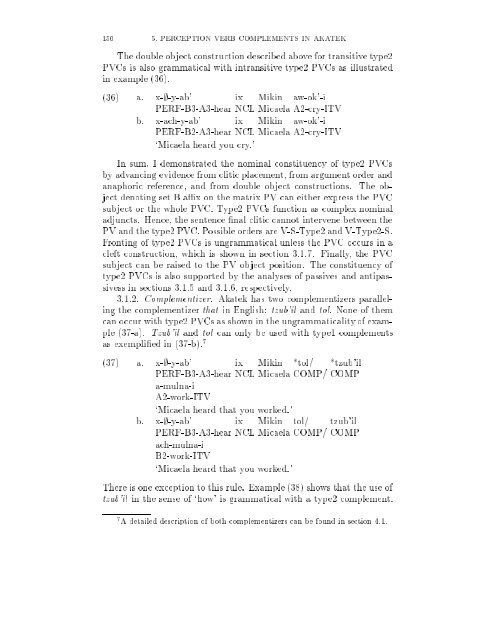Perception verb complements in Akatek, a Mayan language
Perception verb complements in Akatek, a Mayan language
Perception verb complements in Akatek, a Mayan language
You also want an ePaper? Increase the reach of your titles
YUMPU automatically turns print PDFs into web optimized ePapers that Google loves.
150 5. PERCEPTION VERB COMPLEMENTS IN AKATEK<br />
The double object construction described above for transitivetype2<br />
PVCs is also grammatical with <strong>in</strong>transitive type2 PVCs as illustrated<br />
<strong>in</strong> example (36).<br />
(36) a. x-;-y-ab' ix Mik<strong>in</strong> aw-ok'-i<br />
PERF-B3-A3-hear NCL Micaela A2-cry-ITV<br />
b. x-ach-y-ab' ix Mik<strong>in</strong> aw-ok'-i<br />
PERF-B2-A3-hear NCL Micaela A2-cry-ITV<br />
`Micaela heard you cry.'<br />
In sum, I demonstrated the nom<strong>in</strong>al constituency of type2 PVCs<br />
by advanc<strong>in</strong>g evidence from clitic placement, from argument order and<br />
anaphoric reference, and from double object constructions. The object<br />
denot<strong>in</strong>g set B a x on the matrix PV can either express the PVC<br />
subject or the whole PVC. Type2 PVCs function as complex nom<strong>in</strong>al<br />
adjuncts. Hence, the sentence nal clitic cannot <strong>in</strong>tervene between the<br />
PV and the type2 PVC. Possible orders are V-S-Type2 and V-Type2-S.<br />
Front<strong>in</strong>g of type2 PVCs is ungrammatical unless the PVC occurs <strong>in</strong> a<br />
cleft construction, which isshown <strong>in</strong> section 3.1.7. F<strong>in</strong>ally, the PVC<br />
subject can be raised to the PV object position. The constituency of<br />
type2 PVCs is also supported by the analyses of passives and antipassivess<br />
<strong>in</strong> sections 3.1.5 and 3.1.6, respectively.<br />
3.1.2. Complementizer. <strong>Akatek</strong> has two complementizers parallel<strong>in</strong>g<br />
the complementizer that <strong>in</strong> English: tzub'il and tol. None of them<br />
can occur with type2 PVCs as shown <strong>in</strong> the ungrammaticality of example<br />
(37-a). Tzub'il and tol can only be used with type1 <strong>complements</strong><br />
as exempli ed <strong>in</strong> (37-b). 7<br />
(37) a. x-;-y-ab' ix Mik<strong>in</strong> *tol/ *tzub'il<br />
PERF-B3-A3-hear NCL Micaela COMP/ COMP<br />
a-mulna-i<br />
A2-work-ITV<br />
`Micaela heard that you worked.'<br />
b. x-;-y-ab' ix Mik<strong>in</strong> tol/ tzub'il<br />
PERF-B3-A3-hear NCL Micaela COMP/ COMP<br />
ach-mulna-i<br />
B2-work-ITV<br />
`Micaela heard that you worked.'<br />
There is one exception to this rule. Example (38) shows that the use of<br />
tzub'il <strong>in</strong> the sense of `how' is grammatical with a type2 complement.<br />
7 A detailed description of both complementizers can be found <strong>in</strong> section 4.1.

















